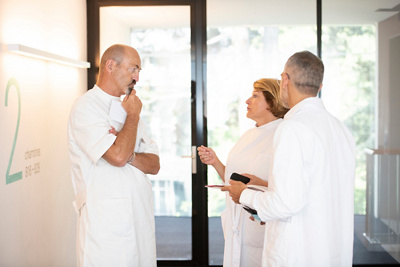If a patient is diagnosed with cancer, her file is discussed at a Multi-Disciplinary Consultation (CMD) meeting before and after therapy in order to propose the best treatment in line with international recommendations.
Every situation is unique and there are many types of breast cancer. The care is adapted according to each patient.
Among the different lines of treatment, we find:
Surgery
This is often the first treatment, performed under general anesthesia, or sometimes local, depending on the size and extent of the tumor. The surgery is performed under the guidance of an experienced gynecologist surgeon, a breast cancer specialist. The objective is on the one hand to completely remove the tumor, and, on the other hand, to check its possible spread in the nearby nodes, most often in the armpit. The scar and extent of removal depend on the size, location, type of tumor and size of the breast.
Surgical treatment is "conservative " if only the tumor is removed. This is called "non-conservative " treatment when the entire breast is removed. In this case, breast reconstruction is proposed, immediate or delayed. It is performed by a plastic surgeon who strives to restore the silhouette of the original breast and the symmetry of the bust. This is essential for patients' body image and is an integral part of the care process. Sometimes several interventions are needed to achieve the desired result. The duration of the operation and that of hospitalization depend on the choice of reconstruction.

Chemotherapy
It is an active drug treatment against cancer cells. It destroys them or stops their multiplication. There are many different molecules, which act differently, depending on the cells they target and the "type" of cancer.
Chemotherapy treatment is administered by a medical oncologist or oncologist.
It makes it possible to:
- shrink the tumour and make surgery easier if chemotherapy is given before surgery
- treat tumours that have spread outside the breast
- prevent recurrence after surgical treatment
Chemotherapy is most often given intravenously (infusion) but it can also be given orally.
Several cycles, or cures of chemotherapy are proposed. They can be done in a doctor's office or clinic. The complete treatment lasts several weeks or months, with each cycle followed by a rest period.
Adverse effects are frequent and of very variable intensity, but they are transient and their management is controlled.


"Targeted" therapies
Targeted therapies make it possible to tailor treatment precisely to the cancer cell of a given tumour.
Treatment with targeted therapies is administered by a medical oncologist or oncologist.

Radiation therapy
This treatment is offered to the majority of patients, and systematically if the breast has been preserved after surgery.
A medical specialist, radiotherapist, takes care of this care.
This is a radiation treatment that aims to prevent the cancer cell from dividing and multiplying. When surgery has already taken place, the intention is to destroy any cancer cells that may have escaped surgical treatment, especially in the rest of the operated breast, and thus reduce the risk of recurrence.
Only a precise and well-defined area is irradiated. Particular attention is paid to preserve unaffected tissue. This makes it possible to limit possible side effects as much as possible.
Radiation therapy sessions last a few minutes and are repeated almost daily for several weeks.

Hormone therapy
This is a drug treatment, prescribed by a medical oncologist or oncologist.
Hormonal therapy can slow or stop the growth of cancer cells that would have escaped other treatments received.
It is an oral treatment that lasts several years, usually between five and ten years, depending on the type of cancer and any side effects that accompany it.

